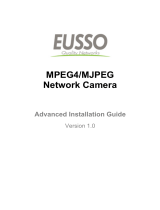
© Copyright 2013 TRENDnet. All Rights Reserved.
1
Product Overview
TV-IP672P TV-IP672PI
Package Contents
In addition to your camera, the package includes:
Multi-Language Quick Installation Guide
CD-ROM (Utility & User’s Guide)
Network cable (1.5m / 5ft)
Power adapter (12V DC, 1.25A)
If any package contents are missing or damaged, please contact the retail store, online
retailer, or reseller/distributor that the item was purchased.
Features
TV-IP672P
The Megapixel PoE PTZ Internet Camera, model TV- IP672P, provides security over a large area.
Pan the camera side-to-side a remarkable 340 degrees and tilt up-and-down 115 degrees from
any Internet connection.
No need to install this camera near a power source, power and data are received through a single
Ethernet cable using Power over Ethernet (PoE) technology (See TRENDnet PoE Switches and
Injectors).
Record 1280 x 800 Megapixel (WXGA) video at up to 30 frames per second (fps). Manage up to
four video profiles to record HD video while streaming low resolution video to a compatible smart
phone at the same time. Manage up to 32 TRENDnet cameras with the included complimentary
camera management software. Advanced features include adjustable motion detection recording
areas, email alerts, scheduled recording sessions, pan/tilt Auto-Patrol, H.264/MPEG-4/MJPEG
image compression, date-and-time overlays, a Micro-SD card slot for backup storage, two-way
audio (speakers not included), an adjustable lens, and four times digital zoom. A wall/ceiling
mounting kit is included and the camera’s off white housing blends into most environments.
TV-IP672PI
The Megapixel PoE Day/Night PTZ Internet Camera, model TV- IP672PI, provides day and night
security over a large area. Pan the camera side-to-side a remarkable 340 degrees and tilt up-and-
down 115 degrees from any Internet connection.
Record indoor video in complete darkness for distances of up to 7.5 meters. No need to install this
camera near a power source, power and data are received through a single Ethernet cable using
Power over Ethernet (PoE) technology (See TRENDnet PoE Switches and Injectors).
Record 1280 x 800 Megapixel (WXGA) video at up to 30 frames per second (fps). Manage up to
four video profiles to record HD video while streaming low resolution video to a compatible smart
phone at the same time. Manage up to 32 TRENDnet cameras with the included complimentary
camera management software. Advanced features include adjustable motion detection recording
areas, email alerts, scheduled recording sessions, pan/tilt Auto-Patrol, H.264/MPEG-4/MJPEG
image compression, date-and-time overlays, a Micro-SD card slot for backup storage, two-way
audio (speakers not included), an adjustable lens, and four times digital zoom. A wall/ceiling
mounting kit is included and the camera’s off white housing blends into most environments.























